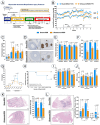Ultrasound Renal Denervation Attenuates Early Cardiac Remodeling After Acute Myocardial Infarction in a Swine Model of Hypertensions and Dyslipidemia: A Pilot Study
- PMID: 41020685
- PMCID: PMC12311393
- DOI: 10.1111/cts.70289
Ultrasound Renal Denervation Attenuates Early Cardiac Remodeling After Acute Myocardial Infarction in a Swine Model of Hypertensions and Dyslipidemia: A Pilot Study
Abstract
Acute myocardial infarction (AMI) patients typically present with a constellation of one or more risk factors including hypertension, dyslipidemia, obesity, or diabetes. Neurohormonal modulation has been a mainstay pharmacotherapy in patients; however, patient compliance is a major obstacle towards clinical efficacy due to side effects and lifelong drug regimens. FDA approval of ultrasound renal denervation (uRDN) for the treatment of resistant hypertension raises the possibility of uRDN therapy for additional disease states involving sympathetic overactivity. In the current pilot study, we sought to explore if prior uRDN has cardioprotective effects against AMI in a comorbid-laden minipig model. Göttingen minipigs (female) were subject to mineralocorticoid excess and a Western high-fat, high-salt diet to induce hypertension, obesity, and hyperlipidemia. Minipigs were randomized to bilateral uRDN (n = 5) treatment or sham-RDN (n = 5) after 4 weeks. After 6 weeks of hypertension and Western high-fat, high-salt diet, animals were subjected to a 75-min left anterior descending coronary artery occlusion followed by 2 weeks of reperfusion. Markers of renal nerve viability, ischemic injury, and cardiac structure and function were assessed. In the uRDN treatment group, there was reduced renal norepinephrine content, improved survival, and reduced myocardial infarct area and calcification compared to sham-RDN treatment. Preservation of the myocardial performance Tei index indicated preserved systolic and diastolic function 2 weeks post AMI. The beneficial effects of uRDN were independent of any reductions in blood pressure. Our pilot study provides new preliminary evidence regarding the efficacy of uRDN in a preclinical large animal model of AMI that features clinically relevant comorbidities.
© 2025 The Author(s). Clinical and Translational Science published by Wiley Periodicals LLC on behalf of American Society for Clinical Pharmacology and Therapeutics.
Conflict of interest statement
The authors declare no conflicts of interest.
Figures

References
-
- Lawton J. S., Tamis‐Holland J. E., Bangalore S., et al., “2021 ACC/AHA/SCAI Guideline for Coronary Artery Revascularization: Executive Summary: A Report of the American College of Cardiology/American Heart Association Joint Committee on Clinical Practice Guidelines,” Circulation 145 (2022): e4–e17. - PubMed
-
- Warren J., Nanayakkara S., Andrianopoulos N., et al., “Impact of Pre‐Procedural Blood Pressure on Long‐Term Outcomes Following Percutaneous Coronary Intervention,” Journal of the American College of Cardiology 73 (2019): 2846–2855. - PubMed
MeSH terms
LinkOut - more resources
Full Text Sources
Medical

